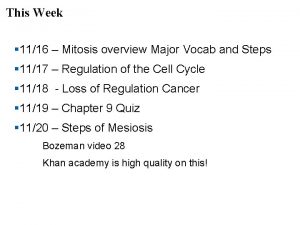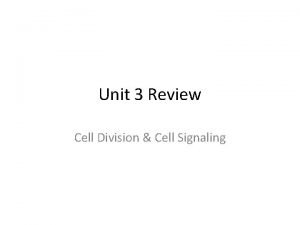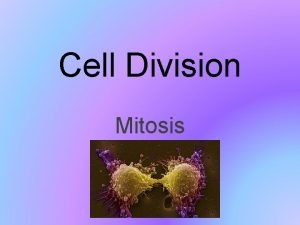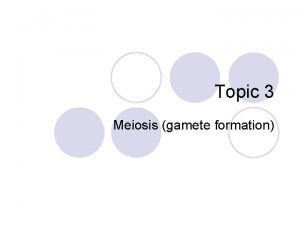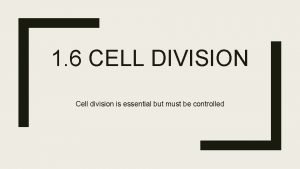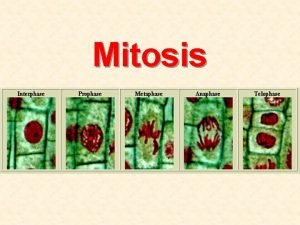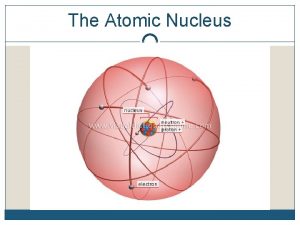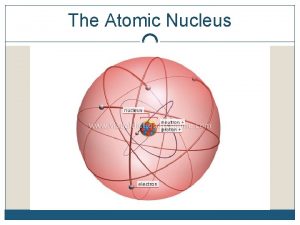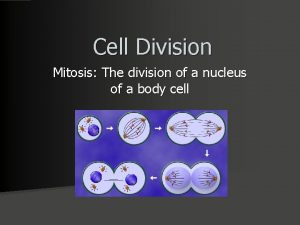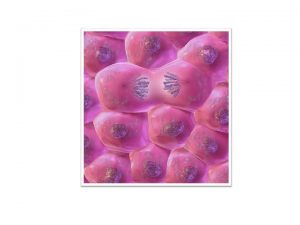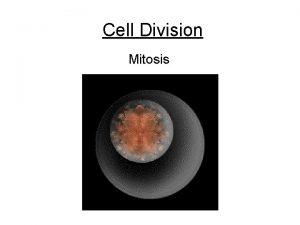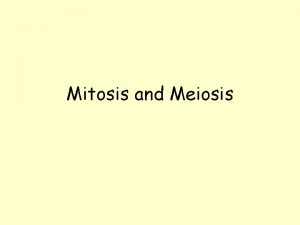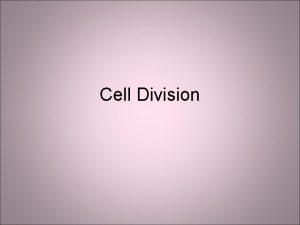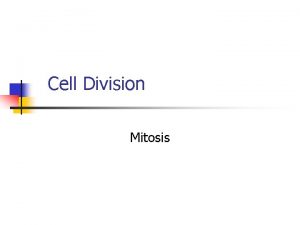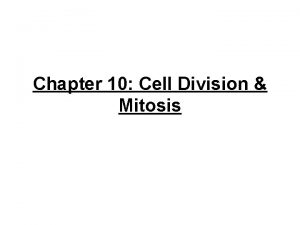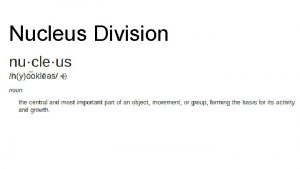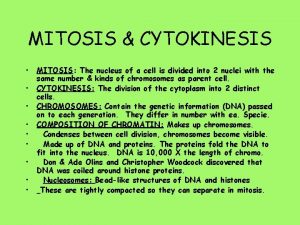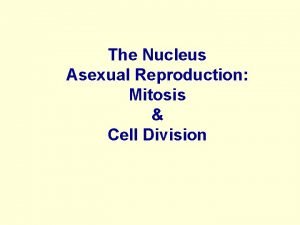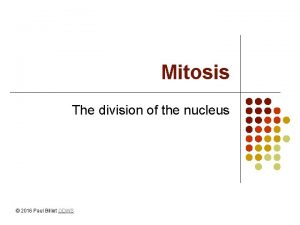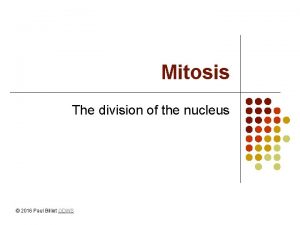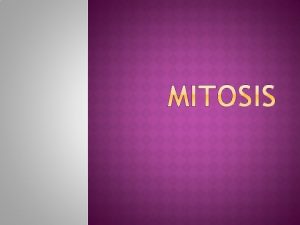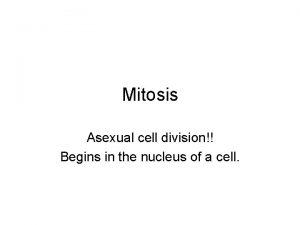Mitosis 1 Mitosis Division of the nucleus Also






































- Slides: 38

Mitosis 1

Mitosis üDivision of the nucleus üAlso called karyokinesis üOnly occurs in eukaryotes üHas four stages üDoesn’t occur in some cells such as brain cells 2

Four Mitotic Stages üProphase üMetaphase üAnaphase üTelophase 3

Prophase üChromatin in nucleus condenses to form visible chromosomes üMitotic spindle forms from fibers in cytoskeleton or centrioles (animal) Nucleolus Chromosomes Cytoplasm Nuclear Membrane 4

Prophase üNuclear membrane & nucleolus are broken down üChromosomes continue condensing & are clearly visible üSpindle fibers attach to the centromere of each chromosome üSpindle finishes forming between the poles of the cell 5

Prophase Chromosomes Nucleus & Nucleolus have disintegrated 6

Spindle Fiber attached to Chromosome Kinetochore Fiber Chromosome 7

Review of Prophase What the cell looks like What’s happening 8

Sketch The Spindle 9

Metaphase üChromosomes, attached to the Centromere, and are moved to the center of the cell üChromosomes are now lined up at the equator Equator of Cell Pole of the Cell 10

Metaphase Asters at the poles Spindle Fibers Chromosomes lined at the Equator 11

Metaphase Aster Chromosomes at Equator 12

Review of Metaphase What the cell looks like What’s occurring 13

Anaphase üOccurs rapidly üSister chromatids are pulled apart to opposite poles of the cell 14

Anaphase Sister Chromatids being separated 15

Anaphase Review What the cell looks like What’s occurring 16

Telophase üSister chromatids at opposite poles üSpindle disassembles üNuclear envelope forms around each set of sister chromatids üNucleolus reappears üCYTOKINESIS occurs üChromosomes reappear as chromatin 17

Comparison of Anaphase & Telophase 18

Cytokinesis üMeans division of the cytoplasm üDivision of cell into two, identical halves called daughter cells üIn plant cells, cell plate forms at the equator to divide cell üIn animal cells, cleavage furrow forms to split cell 19

Cytokinesis Cleavage furrow in animal cell Cell plate in animal cell 20

Mitotic Stages 21

Daughter Cells of Mitosis üHave the same number of chromosomes as each other and as the parent cell from which they were formed üIdentical to each other, but smaller than parent cell üMust grow in size to become mature cells (G 1 of Interphase) 22

Identical Daughter Cells What is the 2 n or diploid number? 2 Chromosome number the same, but cells smaller than parent cell 23

Review of Mitosis 24

Draw & Learn these Stages 25

Draw & Learn these Stages 26

Name the Mitotic Stages: Interphase Name this? Prophase Telophase Name this? Metaphase Anaphase 27

Eukaryotic Cell Division ü Used for growth and repair ü Produce two new cells identical to the original cell ü Cells are diploid (2 n) Prophase Metaphase Chromosomes during Metaphase of mitosis Anaphase Telophase Cytokinesis 28

Mitosis Animation Name each stage as you see it occur? 29

Mitosis in Onion Root Tips Do you see any stages of mitosis? 30

Test Yourself over Mitosis 31

Mitosis Quiz 32

Mitosis Quiz 33

Name the Stages of Mitosis: Early Anaphase Early prophase Metaphase Interphase Late Prophase Late telophase, Mid-Prophase Advanced cytokinesis Early Telophase, Begin cytokinesis Late Anaphase 34

Identify the Stages ? Early, Middle, & Late Prophase ? ? Metaphase Late Prophase Late Anaphase ? ? Telophase ? ? Telophase & Cytokinesis 35

Locate the Four Mitotic Stages in Plants Anaphase Telophase Metaphase Prophase 36

Uncontrolled Mitosis ü If mitosis is not controlled, unlimited cell division occurs causing cancerous tumors ü Oncogenes are special proteins that increase the chance that a normal cell develops into a tumor cell Cancer cells 37

38
 Short division method
Short division method Handwriting คือ
Handwriting คือ Mitosis cell division
Mitosis cell division Mitosis division
Mitosis division Ipmat mitosis
Ipmat mitosis Cell division mitosis and meiosis
Cell division mitosis and meiosis Mitosis division
Mitosis division What are three main parts of the cell cycle
What are three main parts of the cell cycle Mitosis
Mitosis Mitosis division
Mitosis division Mitosis division
Mitosis division Importance of mitosis
Importance of mitosis Recombinant chromosomes
Recombinant chromosomes 369 times 2
369 times 2 Long division vocab
Long division vocab Synthetic divison
Synthetic divison Synthetic dicision
Synthetic dicision Lời thề hippocrates
Lời thề hippocrates Vẽ hình chiếu đứng bằng cạnh của vật thể
Vẽ hình chiếu đứng bằng cạnh của vật thể Quá trình desamine hóa có thể tạo ra
Quá trình desamine hóa có thể tạo ra Các môn thể thao bắt đầu bằng tiếng bóng
Các môn thể thao bắt đầu bằng tiếng bóng Hát kết hợp bộ gõ cơ thể
Hát kết hợp bộ gõ cơ thể Sự nuôi và dạy con của hổ
Sự nuôi và dạy con của hổ Dot
Dot Nguyên nhân của sự mỏi cơ sinh 8
Nguyên nhân của sự mỏi cơ sinh 8 Phản ứng thế ankan
Phản ứng thế ankan Trời xanh đây là của chúng ta thể thơ
Trời xanh đây là của chúng ta thể thơ Chó sói
Chó sói Thiếu nhi thế giới liên hoan
Thiếu nhi thế giới liên hoan điện thế nghỉ
điện thế nghỉ Vẽ hình chiếu vuông góc của vật thể sau
Vẽ hình chiếu vuông góc của vật thể sau Một số thể thơ truyền thống
Một số thể thơ truyền thống Thế nào là hệ số cao nhất
Thế nào là hệ số cao nhất Hệ hô hấp
Hệ hô hấp Số nguyên tố là
Số nguyên tố là đặc điểm cơ thể của người tối cổ
đặc điểm cơ thể của người tối cổ Mật thư anh em như thể tay chân
Mật thư anh em như thể tay chân Các châu lục và đại dương trên thế giới
Các châu lục và đại dương trên thế giới

